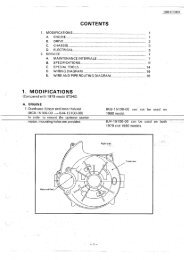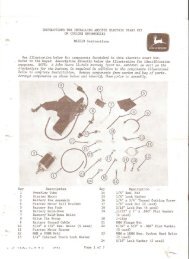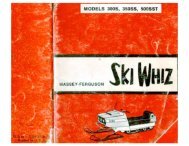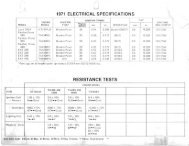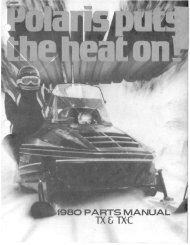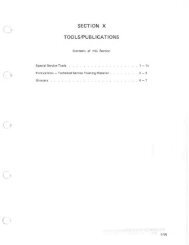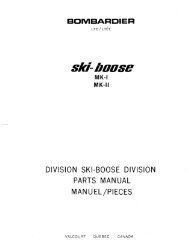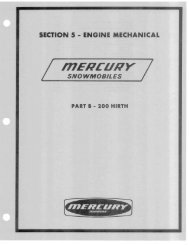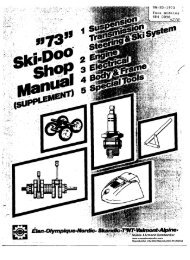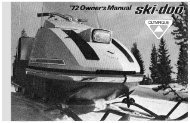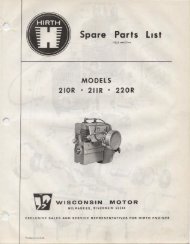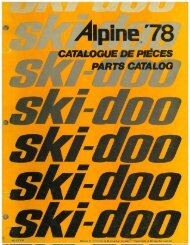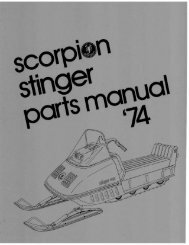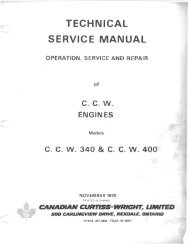1982 Trailfire - Vintage Snow
1982 Trailfire - Vintage Snow
1982 Trailfire - Vintage Snow
- No tags were found...
Create successful ePaper yourself
Turn your PDF publications into a flip-book with our unique Google optimized e-Paper software.
340 TRAILFIRE®and TRAILFIRE® LX<strong>Snow</strong>mobiles(Serial No. 190,001-~t)(X) )~JOHN DEEREALE THIS NEW MANUALHoricon W rksOM-M69139 Issue E1LITHO IN USA
aTo The OperatornThis safety alert symbol identifies importantsafety messages in this manual. Whenyou see this symbol, be alert to the possibilityof personal injury and carefully readthe message that follows.This operator's manual contains Sl Metric equivalentswhich follow immediately after the U.S. customaryunits of measure.Record the snowmobile and engine serial numbers in ()the space below.M28303<strong>Snow</strong>mobile Serial NumberThis operator's manual is prepared for the followingsnowmobiles:John Deere 340 TRAILFIRE (Serial No.J34FL 190001 M- )John Deere TRAILFIRE LX (Serial No.J44FL 190001 M- )<strong>Snow</strong>mobile Serial No.Engine Serial No. ______________Date of Purchase ______________(To be filled in by purchaser.)Engine Serial Numberuu-
ASSEMBLYUnpack Componentsccwa:wI....::;)u1. Skis2. Windshield3. Rear Bumper and <strong>Snow</strong> Flap Support4. Operator's Manual5. Bag of Parts6. Fuel Tank Cap and Gauge.Check Contents of Bag of PartsA - Ski Spring Stop (2 used)B - Ski Pivot Bolt (2 used)C - 13132 x 314-lnch Flat Washer (2 used)D - 318-lnch - 24 Lock Nut (2 used)E - Cotter Pins (2 used)F - Ignition Keys (2)G - Windshield Retaining Rings (7 used)H - John Deere Medallion1 - 1 I 4 x 1-31 4-lnch Cap Screws (4 used)J - 9132 x 1 12-lnch Flat Washer (6 used)K - 1 14-lnch - 20 Lock Nut (6· used)L - 1 14 x 1-1 12-lnch Cap Screws (2 used)NOTE: Hitch plate and cotter pin (not shown) areincluded in the bag of parts with the 440 <strong>Trailfire</strong><strong>Snow</strong>mobile only.M27880Install SkiscNOTE: Bushing is factory inst~lled in steering spindle.1. Install rubber ski spring stop over spindle. Stop isheld in place by the ski sa d~le.2. Position ski so that rear hole of ski is aligned withspindle. Install ski bolt with head of bolt facing out.3. Install 13132 X 31 4-inch flat washer and 318-inchlock nut. Torque nut to 39 ft-lbs (52 Nm). Installcotter pin through bolt.cf.f24900
Install Windshield1. Bend a hook on the end of a 3/32-inch brazing rod.2. Place windshield on hood.3. Place the bent end of the rod through the hole in thewindshield and hook the 0-ring.4. Pull the 0-ring halfway through hole and removehook.Install Rear BumperAssemble rear bumper and snow flap support to tunnelas shown.A-<strong>Snow</strong> Flap SupportB-Rear BumperC-1/4 x 1-3/4-lnchCap ScrewD-1/4 x 1-1/2-lnchCap ScrewE-9/32 x 1/2-lnchFlat WasherF-1/4-lnch - 20 Lock NutPosition Handlebars1. Loosen lock nut securing handlebars in down position.2. Use plastic mallet to loosen aluminum block beforemoving handlebar.3. Move handlebar to desired position. Install two 1/4x 1-3/ 4-inch bolts and 1 I 4-inch lock nuts. Tightenall four nuts securely.4. Install John Deere Medallion.
PREDELIVERY CHECK LISTccCAUTION: When starting snowmobile,support machine so track is clear ofground. Check throttle for proper operation.1. Align skis and check steering linkage.2. Check track tension and align.3. Check brakes. Adjust if necessary.4. Check operation of choke and throttle. Adjust ifnecessary.5. Start engine and check idle speed.6. Check emergency stop and key switch.7. Check operation of all lights.8. Aim and adjust headlight.9. Test drive or dynamometer test snowmobile.10. Install accessories desired by customer.11. Check chain case oil level.1. Explain operator's manual to customer.2. Instruct customer about snowmobile operation.3. Explain fuel and oil injection system (<strong>Trailfire</strong> LX).Use regular (leaded or non-leaded) gasoline withan anti-knock index of 88 or higher.DELIVERY CHECK LIST(_4. Explain to customer the use of pre,.mix gasoline andoil in a 50:1 ratio for the first tank of fuel (<strong>Trailfire</strong>LX). Customer should also fill the oil tank with JohnDeere 2-Cycle Oil or a BIA certified 2-cycle engineoil. After break-in use gasoline only in fuel tank and2-cycle oil in oil tank.5. On 340 <strong>Trailfire</strong>, use a 40:1 ratio for the first tank offuel and a 50:1 ratio thereafter.6. Tell customer about 10-hour or 200 mile check up.Break-In PeriodDo not exceed 40 mph (64 km/ h) for the first 25 miles(16 km}, or force the machine at full throttle in deepsnow. An occasional burst of power on hard-packedsnow will not be harmful.
)).~. I
PERFORM THESE 10 HOUR OR 200 MILE CHECKSThe following inspection must be performed on your new John Deere snowmobile. This should be done atapproximately the first 1 0 hours or 200 miles of operation. It will help assure you of top performance and avoidpremature failure of critical components. Your John Deere dealer is qualified to perform this inspection.Contact your dealer to arrange for an appointment. You are obligated to deliver the snowmobile to the dealer. Anynormal maintenance or repair work reguired, not covered by warranty, will be charged to you should you decide tohave the work done.The inspection check list is as follows:OKAYNEEDSREPAIR1. Track tension.2. Drive belt, drive, and driven sheaves.3. Chain case oil level.4. Carburetor adjustment.5. Carburetor mounting hardware.6. Operation and adjustment of brake, throttle, and choke lever controls.7. Condition of ski wear rods.8 . . suspension hardware.9. Suspension slide wear bars.10. Ski alignment.11. Operation of headlight, stop-taillight, dimmer switch, and emergency stopswitch.12. Fan belt tension.13. Engine head bolts and exhaust manifold nuts.14. Steering component hardware. (Steering arms, tie rods and handlebars).DEALER COMMENTS:Dealer NameTown ________________________________________ __Date
,,~·'
1cContentsPageSafety ..... .... . .... ...... ........... . . 2Identification . . . . . . . . . . . . . . . . . . . . . . . . . . . . 5Preparation . . . . . . . . . . . . . . . . . . . . . . . . . . . . . 6340 <strong>Trailfire</strong> . . ..... .. ...... . . ... . .... . . 6Mix Fuel. . .. .... . . ..... ...... . .... .. 6Fill Fuel Tank .. ...................... 6<strong>Trailfire</strong> LX ... . . .. ... . . ..... .. ......... 7Fill Fuel Tank . . .. . . .. . .............. . 7Fill Oil Tank .. . . . ... .. .. ..... . .. . .. . . 7Fuel Mix For Break-In Period . . . . . . . . . . . . 7Fuel For Temperatures Of - 20°F ( - 29°C)or Below ... .... ... ...... .. ...... . . 7Operation . . . . . . . . . . . . . . . . . . . . . . . . . . . . . . 8Break-In Period . . .. . .... . .. . . .......... 8Before Operating . .... . .. . ......... . .... 8Starting Engine . . . . . . . . . . . . . . . . . . . . . . . . 8Stopping Engine ...... .... .... . ... . . . . . . 9Lights . ... . . .... . ....... . ... .. ....... 10Towing ............. . ..... .... . . . ... . 10Clearing Track . .. .. . . ... . .......... . .. . 1 0Dressing For The Weather ... . . . . .. ....... 11Transporting ... ..... . . ... ...... . . ...... 11Service ... . . ........ .... . . .. ....... . . . . 12Service Interval Chart . ... .. ... . ..... . . . .. 12Spark Plugs. . . . . . . . . . . . . . . . . . . . . . . . . .. 13Carburetor and Oil Injection Pump ... .. . ... . 14Choke System . . . . . . . . . . . . . . . . . . . . . . .14Adjusting Choke Plunger . ....... ... .. . . . 14Adjusting Throttle Cable ..... . .......... 15Adjusting Oil Injection Pump ... .. . ....... 16Checking Float Level ...... . .. .. . . . . . .. 16Oil Injection Pump . ....... . ... . ....... 17In-Line Oil Filter . ......... ....... ..... 17Main Jet Chart .... .. .... . . .... . ... ... 17In-Line Fuel Filter . . ... .. ... . ..... ... .. 18Air Intake Silencer . ... .... .. ... . ..... . 18Checking Fan Belt Tension ..... . . . ...... 18PageDrive System . . . . . . . . . . . . . . . . . . . . . . . . .. 19Servicing Drive and Driven Sheaves . . . . . . . 19Replacing Drive Belt . ... .. . ... . ........ 19Adjusting Brake . . . . . . . . . . . . . . . . . . . . . . 20Checking Chain Case Oil Level. . . .. . .... . 20Checking Chain Tensioner ... . . ... . ..... 20Slide Suspension .......... ... ... . . . .. . . 21Replacing Wear Bars . . .. . ... . . . . ...... 21Adjusting Track Tension ... ...... ..... . . 21Adjusting Suspension Springs ........ . .. . 22Skis .. . ..... ..... . . . . . . .............. 23Replacing Ski Wear Rods .......... ... .. 23Replacing Ski Wear Plates . . . . . . . . . . . . . .23Aligning Skis ...... ... .. . .... . . . .. . .. 24Eliminating Loose Steering . . ........ . ... 24Lighting System ...... . .... . . ... . ... .... 25Adjusting Headlight. .. ....... . . . .. . .. . . 25Replacing Headlight Bulb ... ... .... .. ... 26Replacing Speedometer and TachometerBulbs . ....... . .... . ... . . . ... .. . .. 26Lubrication. . . . . . . . . . . . . . . . . . . . . . . . . . . . . . 27Steering Column Bushing . . . .. .. . .. ..... . . 27Track Drive Shaft Bearing . .... . . . .... .... 27Tightening Hardware and Components .. ....... 28Adjusting Glove Box Door Latch .. ... . .. .. . . .. 28Storage ... . . ..... .... . .. . .. .. . . ... . .... 29Trouble Shooting .. .......... . . . . . ..... . .. 30Specifications ..... ... ...... ... .. .. ...... 32Accessories .. . . . ...... : ......... . .. . .... 34
SafetyCAUTION: Improper use or maintenanceby the operator can result in injury. Followthese safety suggestions.PreparationBefore starting the engine, read your operator's manualfrom cover to cover. Knowledge can prevent accidents.Always operate your throttle and brake controls severaltimes before you start your engine. Stuck or frozencontrols could cause serious injury or damage.Know your controls. Learn how to stop in an emergency.Know your state, provincial, federal and local lawspertaining to snowmobiling. Respect property ofothers. Don't spoil this fine winter sport by creating abad image.Never add fuel when smoking or while engine is running.Use a safe gasoline container. Always use fresh,clean fuel of the proper mixture. See pages 6 and 7.M23365Wear clothing designed for snowmobiling . .. avoidfrostbite. Never wear scarves, loose belts, or clothesthat could catch on moving parts or tree limbs.Always wear eye and headgear protection to guardagainst injury.Prolonged exposure to loud noise can cause impairmentor loss of hearing. Wear earplugs or any suitablehearing protective device that is comfortable whenwearing a snowmobile helmet to protect against objectionableor uncomfortable loud noises. Always wearan approved helmet to guard against head injury.A void sun blindness. Wear properly tinted goggles orface shields. Never wear yellow eye protection in thebright sun.Do not allow anyone to operate snowmobile withoutproper instructions. Take proper precautions beforeallowing young operators to drive.Always use the "buddy system". Remember you candrive farther in 30 minutes than you can walk in a day.Carry adequate tools and repair items for emergencyfield repairs.Don't overload your snowmobile . .. use sleds to carryprovisions. ·
Safety 3rcAlways carry emergency survival supplies when goingon long trips. Let friends and relatives know yourdestination and expected arrival time.OperationGive complete and undivided attention to your snowmobile.. . don't be a show-off.Do not operate snowmobile in crowded areas or steerthe machine toward persons.Do not operate snowmobile too close to avalancheareas, or on other unsafe terrain where spills couldoccur.Observe all state, provincial, federal and local regulations,especially those with regard to operating onstreets and highways.When crossing highways (where permitted by law)always stop, look both directions, and cross at a 90-degree angle. Post guards when crossing in groups.Do not operate snowmobiles on or near railroad tracks.Trains cannot always be heard above sound of snowmobileengine ... it is difficult to escape from betweentracks.Skiers and snowmobiles don't mix on the same hillsides.Avoid ski slopes.Never operate snowmobile on rivers or lakes withoutfirst checking thickness of ice. If you go through the ice,don't panic. Conserve energy.Never operate snowmobile at night without lights. Keepheadlight and taillight areas free of snow.Keep all shields in place . . . all guards and protectivehoods.Never open new trails at night. Follow establishedtrails. Unseen barbed wire or guy wires can causeserious injury or death.Always use both hands for steering.Avoid operating snowmobile at excessive speed.Always be aware of terrain.M23364If throttle sticks, don't panic. Turn emergency stopswitch on the right-hand handlebar. See page 9.Always allow adequate stopping distance based onground cover conditions. Remember, ice requires agreater stopping distance. To avoid skidding, don'tapply brakes rapidly on ice.Ice or hard surfaces do not provide the same stabilityas snow. Drive slower on these surfaces. Do notaccelerate rapidly.Be sure tool box lid is closed at all times. An open lidcould cause interference with steering or possiblecontact with the throttle lever producing unexpectedacceleration.M23366
4 SafetyDo not speed through wooded areas. Hidden obstructions,hanging limbs, unseen ditches, and even wildanimals can cause accidents.Do not tailgate when riding trails. Rear end collisionscan cause injury and machine damage.Don't mix alcoholic beverages with snowmobiling.Keep feet on footrests at all times. Do not permit themto hang over sides. Do not attempt to stabilize machinewith feet when making turns or in near-spill situations.Broken limbs could result.Select a riding position suited to the terrain upon whichyou're operating. Do not stand on seat, stunt, orshow-off.Do not jump snowmobile. Operator injury or machinedamage could result.Keep hands and feet out of the track area . .. be especiallycareful when freeing your snowmobile from deepsnow.When towing a sled, use a solid towbar. Do not useropes or other flexible tow straps. See page 1 0.Observe fuel supply regularly. Do not travel fartherthan your fuel will permit you to return.Remove key from switch whenever you leave yourmachine unattended.Never drive your snowmobile onto a tilt-bed trailer.Winch it on.Always secure snowmobile firmly to trailer. Be suretrailer lights are operative.Maintenance and StorageCheck over your snowmobile regularly. This will preventmany problems from occurring.Do not attempt to make repairs to your snowmobilewhile engine is running.Keep matches away and do not smoke while filling thefuel tank. Avoid possible explosions.Check skis and steering components frequently to seethey are in good condition. Keep all hardware tight.Never lift the rear of the snowmobile to clear the track.Chunks of ice or rocks may be thrown rearward. Tiltmachine on one footrest when clearing track ... andkeep all persons clear of area. Keep hands and feetclear of track.M22 1 22
5cIdentificationA-Shock AbsorbersB-SkisC-Front BumperD-HoodE-HeadlightF -WindshieldG-Brake ControlH-SeatI -Rear BumperJ -TrackK-PanL -Ski Spring)JM28304A-<strong>Snow</strong> FlapB-Hitch (TRAILFIRE LXonly)C-Rear BumperD-Stop-TaillightE-SeatF-Throttle ControlG-Fuel TankH-HoodI - Ski HandleJ -Recoil 'StartK-TrackL-<strong>Snow</strong>mobileSerial Number'M28305
Preparation340 TRAILFIREMIX FUELIMPORTANT: Use regular leaded or non-leadedgasoline with an anti-knock index of88 or higher, mixed with 2-cycle oilin the proper ratio. Never use gasolinethat has been stored for a longtime.NOTE: Regular (leaded) gasoline is preferred butnon-leaded gasoline is acceptable.Use John Deere 2-cycle oil or an equivalent BIA approved2-cycle oil. Mixing is improved if the oil is atroom temperature.The correct fuel-oil mixture is a 40:1 ratio for the firsttank of fuel and a 50:1 ratio thereafter. See page 33.A CAUTION: Use safe mixing procedures:Use an approved container for storage and refueling.Mix fuel outdoors.Do not smoke.Do not spill fuel.1. Pour half the gasoline into container.2. Pour in all the oil.3. Shake mixture vigorously.4. Pour in remaining gasoline.5. Shake mixture vigorously.NOTE: Mix gasoline and oil in a separate container -never mix in the snowmobile fuel tank. Agitatestored mixtures thoroughly before using.FILL FUEL TANKA CAUTION: Use safe refueling procedures.Fuel snowmobile outdoors.Do not smoke.Avoid spilling fuel. Do not overfill.Clean area around fuel tank of any spilled fuel.Fill tank to bottom of filler neck.
Preparation 7TRAILFIRE LXFILL FUEL TANKcIMPORT ANT: Use regular leaded or non-leadedgasoline with an anti-knock index of88 or higher. Never use gasoline thathas been stored for a long time.NOTE: Regular (leaded) gasoline is preferred butnon-leaded gasoline is acceptable.NOTE: When running snowmobile in powder snow orblowing snow add gasoline de-icer to the fueltank. Use ONLY one 12 ounce can per tank offuel.CAUTION: Excessive amounts of gasolinede-icer will lean out the fuel mixture andcould cause engine damage.NEVER ALLOW OIL TANK TO BECOME EMPTY. UseJohn Deere 2-cycle oil or a BIA approved 2-cycleengine oil. Oil tank holds 3.5 U.S. pints (1 . 7 L).IMPORT ANT: If other than John Deere 2-cycle oilis used, it must meet BIA (BoatingIndustry Association) test qualificationTCW.Never use dirty or contaminated oil.The oil and oil tank must remainclean to avoid oil injection pumpfailure and engine damage.FILL OIL TANKM28307For the first tank of fuel, pre-mix gasoline and oil in a50:1 ratio (1 pint of oil with 6 U.S. or 5 Imperial gallons)and fill fuel tank. Fill the oil tank with John Deere2-cycle oil or its equivalent.After the break-in period, use ONLY GASOLINE in thefuel tank and John Deere 2-cycle oil or its equivalent inthe oil tank.FUEL MIX FOR BREAK-IN PERIODFUEL FOR TEMPERATURES OF -20°F (-29°C) OR BELOWIMPORTANT: Use a 50:1 gasoline and oil pre-mixin the fuel tank and fill the oil tankwith 2-cycle oil. DO NOT usestraight gasoline in the fuel tank.The oil injection system may notfunction efficiently at - 20°F (- 29°C)and this could cause engine failure.
OperationBREAK-IN PERIODDo not exceed 40 mph (64 km/h) for the first 25 miles(16 km), or force the machine at full throttle in deepsnow. An occasional burst of power on hard-packedsnow will not be harmful.BEFORE OPERATING1. Clean windshield with a damp cloth. Do not usegasoline, solvents, or abrasive cleaners.2. Check skis, wear rods, and all steering components.Check steering for a full right and left-handturn.3. Check track for proper tension.4. Check fuel level.Normal ChokeRicher ChokeSTARTING ENGINEACAUTION: Be sure area in front of machine.. is clear. Be prepared to apply brake toprevent snowmobile movement.Cold Starting1. With no choke and no throttle, pull recoil start to turnengine over two or three times.2. Flip choke lever straight up (normal position). Inextremely cold weather, flip choke over center allthe way (richer position).3. Emergency stop switch must be in center position.4. Turn key switch "ON". DO NOT press throttle lever.5. Pull recoil start rope.6. When engine starts, allow it to run briefly beforepushing choke lever down.NOTE: If choke was in rich position, push down tonormal position and allow engine to warm up.7. If engine becomes "flooded", close the choke. Holdthe throttle in wide open position. Pull start ropeuntil engine "pops". Release throttle. Pull recoilstart rope until engine starts.NOTE: Remove and dry plugs if engine is extremelyflooded.IMPORTANT: DO NOT permit engine to idle forlong intervals. Shut engine offwhenever you stop.
Operation 9Warm Starting1. Emergency stop switch must be in center position.2. Turn key switch "ON".3. Pull recoil start rope.NOTE: DO NOT use choke.Emergency Starting1. Raise the hood. Raise the belt guard.2. Place start rope from tool kit around primary clutchas shown.3. Pull on rope to start engine.M28308STOPPING ENGINE1. Release throttle lever.2. Turn emergency stop switch up or down.3. Apply brake.4. Before restarting, emergency stop switch must beturned to center position. Always check emergencystop switch before attempting to start engine.5. Turn key switch "OFF". Remove key before leavingmachine unattended.
10 OperationLIGHTSNOTE: The lights are automatically "ON" wheneverthe engine is running.1. Stoplight comes on when brake is applied.2. Turn dimmer switch to low beam.3. Turn dimmer switch again for high beam.NOTE: If one filament of bulb fails, the other beam canstill be used. See pages 25 and 26 for adjustingheadlight and changing bulbs.M24911TOWINGCAUTION: Always use a solid tow barwhen possible. Flexible ropes or pullstraps do not allow for control on turns orfor stopping.1 . Remove the drive belt.2. Connect only one ski of disabled machine to the towmachine.3. DO NOT use rear bumper for towing.M283224. When towing with a rope or strap, run rope throughski handle and around ski spindle. Do not loop ropeor strap through both skis. This may damage thesteering tie rod.CLEARING TRACK1. Clear track after operating in slushy snow.2. Tip machine on its left side until track clears theground.3. Spin track at moderate speed until snow and ice arethrown clear.hCAUTION: Be sure no one is behind maftchine when clearing track. Injury could resultfrom ice or rocks thrown from track.IMPORTANT: If track freezes, free it manually. Donot use the engine to break trackloose. The drive belt will be burnedand damaged.
Operation 11DRESSING FOR THE WEATHERc1. To prevent frostbite, dress for the wind andweather.2. Wear protective clothing and accessories.3. The chart provides a guide and illustrates thedanger zones.CAUTION: Always wear a snowmobilehelmet. The helmet provides both warmthand protection against head injury.WIND CHILL CHARTESTIMATEDWIND SPEEDIN MPHACTUAL THERMOMETER READING (°F.)50 40 30 20 10 0 -10 -20 -30EQUIVALENT TEMPERATURE (°F.)5 48 37 27 16 ~ -36 -3010 40 28 16 4 -58calm 50 40 30 2015 36 22 9 -5 -7220 32 18 4 -10 -25 -39 -53 -67 -8225 30 16 0 - 15 -29 -44 -59 -74 -8830 28 13 -2 -18 -33 -48 -63 -79 -9435 27 11 -4 -20 -35 -49 -67 -82 -9840 26 10 -6 -21 -37 -53 -69 -85 -100 . -116(Wind speeds LITTLE INCREASING GREATgreater than40 mph have DANGER DANGER DANGERlittleaddi-(for properly clothedtional effect.) person) Danger from freezing of exposed flesh-40-40-47-70-85-96-104-109-11 3-50 -60-50 -60-57 -68-83 -95-99 -112-11 0 -124-11 8 - 133-125 -140-129 -145-132 -148M10123TRANSPORTINGClose fuel shut-off valve when transporting the snowmobile.Shut-off valve should also be closed whensnowmobile is stored. Valve is off when handle isstraight up.M28309
ServiceSERVICE INTERVAL CHARTEvery EveryAs 150 300Item Needed Daily Miles Miles Annually PageClean windshield. X 8Check con~ition of skis and steering. X 23,24Check track condition and tension. X 21,22Check throttle control operation. X 14,15,16Check operation of brakes. X 20Check emergency stop and key switch. X 9Check lighting system. X 10Check chain case oil level. X 20Check chain tensioner. X 20Check in-line fuel filter. . X 18Check in-line oil filter. X 17Check oil injection pump. X 17Grease L.H. track drive shaft bearing. X 27Grease steering column bearing. X 27Check drive belt condition. X 19Check carburetor adjustments. X X X 14,15,16Check choke adjustments. X X X 14Check fan belt tension. X X 18Check ski alignment. X 24Check headlight adjustment. X 25Check .ski wear rods and wear plates. X X 23Check slide suspension wear bars. X X 21Lubricate throttle cable. X 16Check all components for condition andtightness. X 28Service drive and driven sheaves. X 19Store snowmobile properly. X 29
Service 13SPARK PLUGScRemoving Spark PlugsCAUTION: High-energy ignition systemscan produce injurious electrical shock.Stop engine and remove key before workingon ignition.1. Stop engine.2. Pull spark plug wire connectors from plugs.IMPORTANT: Do not pull on wire to remove connectors.Pull on connectors only.3. Remove plugs.Checking Spark PlugsACAUTION: Do not hold the plug or plug.. wire in your hand when checking for spark.1. Reconnect spark plug wire to plug.2. Lay plug on engine.3. With ignition "ON," pull recoil start rope and checkfor spark.New plugs are gapped at 0.025 inch (0.635 mm). Thegap will widen in proportion to the hours and miles ofuse. When plug gap reaches 0.045 inch (1.143 mm), orif plug malfunctions, replace it.Plug AppearanceTan or Cocoa BrownBlack or SootyWhite or Light TanPossible CauseProper fuel mixture, goodcombustion.Fuel mixture too rich, poorcombustion.Fuel mixture too lean, hotcombustion.NOTE: Replace plug if appearance is abnormal, enginestarts hard or malfunctions.Installing Spark Plugs1. Clean plug seating surface on cylinder head.2. Install plugs and tighten to 20 ft-lbs (27 N·m) torque.3. Connect spark plug wires.
16 ServiceAdjusting Oil Injection PumpIMPORTANT: The oil injection pump lever must beadjusted to move off the peg at exactlythe same time that the carburetorthrottle valves start to rise.Adjust oil injection pump as follows:1. Loosen the two jam nuts securing the oil injectionpump control cable adjusting sleeve.2. Back sleeve out to tighten cable or turn in to loosencable. Cable should have slight free-play; it shouldnot be stretched tight.3. Press the throttle lever on the handgrip and observethrottle valve and oil injection pump control lever.The throttle valve and lever should start to move atexactly the same time.4. When adjustment is correct, tighten the jam nutssecuring the oil injection pump control cable adjustingsleeve.M28310IMPORT ANT: Lubricate throttle cable once eachseason with LPS or WD-40. Hold thethrottle lever against the handgripand allow lubricant to run downcable. DO NOT use engine oil orsilicon spray. These lubricants maydestroy the plastic components ofthe throttle cable or cause controlcable to become sticky in cold temperatures.Checking Float LevelNOTE: The fuel level in the float mixing chamber isregulated by the float.1. Remove air intake silencer, fuel lines and carburetorfrom engine.2. Remove float chamber body and gasket.3. Invert carburetor. Float arm (B) should be parallelwith edge of mixing chamber (A). If adjustment isnecessary, bend only the float arm actuating tab.A- Mixing Chamber B-Fioat Arm
Service 17Check oil flow annually. See your John Deere dealerfor this service.OIL INJECTION PUMPIN-LINE OIL FILTERReplace oil filter annually or immediately if oil level intank does not drop. Minimum oil level at bottom of tankmust be 3 inches (76 mm) for oil pump to functioncorrectly.\\'IM28312MAIN JET CHARTcCarburetor and clutch changes, adjustments, or modificationsmay be necessary for operation at altitudesabove 4000 feet. See your John Deere dealer.TEMPERATURESNOWMOBILE 0°F and Below 0°F and Above- 18°C and Below - 18°C and AboveALTITUDEMain JetMain Jet340 <strong>Trailfire</strong> 200 190*<strong>Trailfire</strong> LX 240 230*Sea Levelto 4000 Feet(1 219 m)*Factory Installed
18 ServiceIN-LINE FUEL FILTERChange the filter annually or when contaminationbuilds up.AIR INTAKE SILENCERThe first indication of trash in the silencer will be loss ofpower and performance. The engine will run "rich"because adequate air will not be mixing with the fuel.1. Remove silencer.2. Shake or blow out silencer to remove any trash.3. Install silencer.IMPORTANT: DO NOT run engine with air intakesilencer removed. Serious enginedamage will result.CHECKING FAN BELT TENSIONRemove fan cover.Use your finger to deflect belt as shown. If more than3/8-inch (9.52 mm) deflection is possible or if beltcondition is questionable, see your John Deere dealer.
Service 19DRIVE SYSTEMServicing Drive and Driven SheavesOnce a year, service the drive and driven sheaves.See your John Deere dealer for this service.Replacing Drive BeltThe drive belt should be replaced if its width is reducedby 1/8 inch (3.18 mm). A narrow belt reduces snowmobiletop speed. Correct width is 1-1/4 inches (31.75mm).ccIf drive belt wears rapidly, drive and driven sheavesmay be out of alignment. See your John Deere dealer.A belt worn narrow in one area is caused by trying tofree a frozen track with the engine. Free a frozen trackmanually before starting engine.ACAUTION: Keep fingers out of area betweendriven sheave halves. If drivensheave sticks, use care in opening it toprevent hand from being pinched.1. Push in on center of driven sheave and lift belt upand over sheave half.2. Remove belt from drive sheave.IMPORTANT: Never pry belt over sheaves.3. Install belt in reverse sequence. Always install beltso that number on belt can be read when viewedfrom the left-hand side of the snowmobile.NOTE: As belt wear increases or if belt stretches,remove spacer washer (A) from behind retainingwasher (8). When new belt is installed,replace washer. Torque cap screw to 20 ft-lbs(27 Nm). If snowmobile has a tendency tocreep at idle speed after installing a new belt,add a washer.A- Spacer Washer8-Retaining Washer
20 ServiceAdjusting Brake1. Apply the brake control lever and measure thedistance from the lever to the handgrip. It should be1 to 1-1/2 inches (25 to 38 mm).2. Adjust brake by loosening jam nut and turning capscrew in. Retighten jam nut securely./').ACAUTION: DO NOT adjust jam nuts onbrake cable.3. Check brake tension.4. Readjust if necessary.NOTE: Be certain dowel on end of brake cable isseated properly in recess of brake controllever.5. After brake adjustment, check operation of stoplightswitch. If stoplight does not work, check for a defectiveswitch.Checking Chain Case Oil Level1 . Park snowmobile on a level surface.2. Remove lower plug from chain case. If oil flows fromthis hole, oil level is satisfactory.3. To add oil, remove upper plug and add API-GL5gear oil until it flows from lower hole.4. Install plugs.M?R.'=114Checking Chain Tensioner1. Turn snowmobile on its left side. Remove chaincase cover.2. Check chain tensioner for wear. When tensioner isworn until only 1/16 inch (1 .588 mm) of materialremains, replace the tensioner.3. Install cover. Add oil to chain case if required. Wipeany spilled fuel from the pan or sheaves.
Service 21SLIDE SUSPENSIONThe slide suspension system requires lubrication betweenthe plastic wear bar and metal grouser bar. Theabsence of lubrication (snow or water) causes theplastic wear bar to wear rapidly and in severe cases,literally melt away.cOperation of the snowmobile under the following conditionsshould be avoided.1. Dirt2. Rocks3. Sand4. Grass5. Bare Pavement6. <strong>Snow</strong> permeated with dirt and sand.7. Glare ice surfacesIMPORT ANT: When running on ice or hard packedsnow at high-speed, the wear barswill heat up. Either reduce speed, orfrequently stop and apply ice orsnow to the track to lubricate thewear bars.Replacing Wear BarsWhen running in marginal snow conditions, check wearbars daily.1. Tip snowmobile on its side.2. Check wear bars in several places for cracks, thinareas and sand or gravel imbedded in the bar.NOTE: Sand or gravel imbedded in the wear bars actsas an abrasive and will destroy the steelgrouser bars in the track.3. If any of these conditions exist, see your JohnDeere dealer for wear bar replacement.Adjusting Track TensionCheck track tension and alignment frequently. A loosetrack causes excessive slap and could damage thetrack, tunnel or slide assembly. A tight track requiresadditional power to operate.1. Suspend or support snowmobile so track is clear ofground.2. Loosen jam nuts (A) an track adjusting screws (B).3. Turn adjusting screws (B) to tension track.4. Measure below the lower shock absorber mount forclearance of flush to 1/ 4 inch (6.35 mm) betweentrack and slide wear bar. Both sides should beequal. Tighten jam nuts.A-Jam NutsB-Adjusting Screws
22 ServiceAfter Adjusting Track Tension1. Start engine and allow track to rotate slowly severaltimes. Shut off engine and allow track to coast to astop. DO NOT APPLY BRAKE TO STOP TRACK.2. Check alignment. Rear idler wheels should run incenter of drive lugs.3. Slide rail wear bar should be in middle of each sliderail opening of track.4. If either Step 2 or 3 indicates a need for adjustment,repeat the procedure.NOTE: Track will run to the loose side. If track is toofar to the left, tighten the left adjusting screw tomove the track to the right.Adjusting Suspension SpringsRide the snowmobile to determine adjustment requirements.Front SpringsIf the front springs are tightened too much, the ride willbe stiff and the front of the snowmobile will seem lightand lift up when power is applied. Added lift is fine fordeep snow but makes the ride choppy on rough surfaces.Front torsion springs are not the only adjustmentfor ski lift, but they do contribute.To reduce spring tension, turn adjusting nuts counterclockwise.Be sure that at least two threads of theadjusting screws protrude through the nuts.Rear SpringsTo increase tension, move the springs from the bottomposition (A) to the top position (B).A-Bottom PositionB-Top Position
Service 23SKIScReplacing Ski Wear RodsWear rods should be replaced when they are worn toone-half their original size.1. Remove lock nuts securing wear rod to ski. '2. Pry rod down to free studs from holes.3. Slide rod forward to remove rod from rear hole.4. Install new rod in opposite sequence.cM23322Y.Replacing Ski Wear PlatesReplace wear plates when excessively worn.1. Raise front of snowmobile.2. Remove cotter pin (A) and drilled pin (B).3. Lift spring and remove wear plate (C).4. Install new wear plate.5. Lower spring and install drilled pin and cotter pin.M26?14A- Cotter PinB-Drilled PinC- Wear Plate
24 ServiceAligning SkisWhen properly aligned, skis are parallel and handlebarsare positioned straight ahead.1. Raise front of snowmobile slightly to take weight offskis.2. Disconnect drag link from steering arm.3. Loosen jam nuts on tie rod ends. Gold-colored tierod has left-hand threads. Loosen nuts oppositenormal rotation.4. Turn tie rod to align skis. Measure from straightedge of skis; not tapered ends. Distance should beequal at locations shown.IMPORTANT: DO NOT exceed 1-5/16 inches (33.34mm) between tie rod . and center oftie rod end when adjusting tie rod.5. Tighten jam nuts on each end of tie rod (A). Hold tierod when tightening jam nuts. This prevents strippingthreads in ball joint.IMPORTANT: After jam nuts are tight, be sure tierod ends swivel freely.6. Turn drag link (B) as required to position handlebarsstraight ahead. Reconnect drag link to steering arm.IIIIIIIIIIIIIIIUIIII\11M28315-Eliminating Loose Steering/). CAUTION: Check steering components.. and hardware frequently for condition andtightness.The two major causes of loose steering are:1. Excessively worn tie rod ends (A).2. Excessively worn spindle bushings (B).3. Replace or tighten parts as required ..A-Tie Rod EndB-Spindle Bushing
Service 25LIGHTING SYSTEMc25'(7.6 m)c16- 1/ 4"(41 .2 em)M23 326Ad justing Headlight1. Position snowmobile on a flat surface with theheadlight 25 feet (7.6 m) from a vertical surface.2. With operator on seat and headlight on "HIGH"beam, light beam center line should be straightahead and 16-1/4 inches (41 .2 em) above groundlevel.I3. Loosen or tighten the two adjusting screws to raiseor lower the light beam.4. Loosen or tighten the adjusting screw to move thelight beam right or left.c
26 ServiceReplacing Headlight Bulb1. Disconnect wiring harness from the light bulb.2. Push and turn bulb counterclockwise to removebulb.3. Install new bulb in opposite sequence.IMPORTANT: Be sure bulb locking tabs matchslots.4. Connect wiring harness to light bulb.Replacing Stop-Taillight Bulb1. Remove lens.2. Push and turn bulb counterclockwise to remove it.3. Install new bulb in opposite sequence.IMPORTANT: Be sure bulb locking tabs matchslots.Replacing Speedometer and TachometerBulbs1. Pull the bulb socket out of the instrument.2. Push and turn bulb counterclockwise to removebulb from socket.3. Install new bulb in opposite sequence.
Service 27LUBRICATIONSteering Column BushingLubricate grease fitting at the lower end of the steeringcolumn once each year. This should be done prior tothe summer storage period. Apply 2 to 3 shots ofmultipurpose grease.cM28318Track Drive Shaft BearingThe left-hand bearing is subjected to large amounts ofwater during some types of running. The bearingshould be re-lubricated after any excessive use in verywet conditions. Use 2 to 3 shots of multipurposegrease.Also lubricate the bearing when the snowmobile isprepared for summer storage.M28319
28 ServiceTIGHTENING HARDWARE AND COMPONENTSM28320Check hardware and components for tightness, wearand damage on a yearly basis. Replace any parts thatare questionable.ACAUTION: Worn, bent or damaged ski and.. steering components are unsafe.1 . Wear ~od nuts.2. Ski bolts.3. Steering arm bolts.4. Tie rod end bolts.5. Secondary shaft bearing cap screws.6. Driven sheave cap screw.7. Muffler clamp.8. Throttle and choke cables.9. Intake manifold nuts.10. Carburetor attachment.11. Engine mounting bolts.12. Drive sheave cap screw.13. Suspension cap screws.14. Shock absorber screws.Adjusting Glove Box Door Latch1. Open glove box door.2. Loosen screws and move latch forward or rearward.3. Tighten screws.M28321
29ccPlacing <strong>Snow</strong>mobile in Storage1. Thoroughly clean snowmobile.2. Polish hood, pan and tunnel with automotive-typewax. Use upholstery cleaner on seat. Touch-up allbare metal parts with paint.3. Check cap screws and components for tightness.Order any new parts required.4. Drain fuel tank until there is approximately 1 gallon(3. 785 L) of fuel in the tank. Add 2 ounces (59.1mL) of fuel stabilizer to the fuel tank. Run enginefor 5 minutes to distribute the fuel through thesystem and carburetor. Drain fuel tank.5. Replace in-line fuel fifter.6. Remove spark plugs and add 1 teaspoon of 2-cycle oil in each cylinder. Pull recoil start rope sixor seven times to lubricate cylinder walls. Replaceplugs.7. Remove drive belt and coat drive and drivensheaves with light grease.8. Change oil in chain case.9. Support snowmobile so track is clear of ground.Loosen track adjusting screws.Storage10. Place cover on snowmobile and store inside.cRemoving <strong>Snow</strong>mobile From Storage1. Wipe grease from drive and driven sheaves. Installdrive belt.2. Fill oil tank (<strong>Trailfire</strong> LX) and fuel tank.3. Check throttle and brake controls for proper adjustmentand operation.4. Adjust track tension.5. Review operating and safety suggestions.6. Start engine and test operation of all switches andlights.7. Ride snowmobile at slow speed until you are sure itis operating properly.
Trouble ShootingEngineEngine Starts Hard or will Not StartFuel tank empty.Emergency stop switch in "OFF" position.Plugged in-line fuel filter.Fuel pump malfunctioning.Faulty ignition system.Ignition timing incorrect.Idle set too high.Engine Lacks Power or AccelerationRunning on one cylinder.Throttle cable improperly adjusted.Improper fuel mixture.Carburetor out of adjustment.Restricted in-line fuel filter.Ignition timing incorrect.Engine Backfires and Runs UnevenlyIgnition timing incorrect.Engine OverheatsCarburetor set too lean.Intake manifold or carburetor leaking.Engine fan belt slipping or broken.Fan blade(s) broken off.LightsStoplight Not WorkingBulb burned out.Stoplight switch defective.Lights Won't LightBulbs burned out.Loose electrical connections.Faulty lighting coil.
Trouble Shooting 31ccPower Train and TrackClutch Does Not Engage ProperlyEngine idles too fast.Faulty clutch.Short drive belt.Clutch Engages SlowlyFaulty clutch.Stretched or worn drive belt.Excessive Drive Belt WearDriving long distances at clutch engagementspeed.Freeing frozen track with engine.Drive and driven sheaves misaligned.Rapid Track WearOperating on bare ground.Track improperly tensioned.Skis and SteeringLoose SteeringWorn tie rod ends.Worn spindle bushings.Poor ManeuverabilityWorn ski wear rods .Loose steering linkage.c
SpecificationsSNOWMOBILE SPECIFICATIONSComponent Item 340 TRAILFIRE TRAILFIRE LXEngine Manufacturer John Deere " Fireburst"* John Deere " Fireburst" *Model TA340A TA440ANo. of Cylinders 2 2Bore 60 mm 68 mmStroke 60 mm 60 mmDisplacement 339 cc 436 ccFuel System Carburetor Manufacturer Mikuni MikuniCarburetor No. AM55053 AM55054Tank Capacity 7.5 Gals. (28.4 L) 7.5 Gals. (28.4 L)Fuel Mixing Ratio See page 33 See page 33Chassis and Body Tunnel Alum inum AluminumPan Thermoplastic Rubber Thermoplastic RubberHood Sheet Molded Compound Sheet Molded CompoundWindshield Polycarbonate PolycarbonateOverall Length 102 in. (2 590.8 mm) 102 in. (2 590.8 mm)Overall Width 37 in. (939.8 mm) 37 in. (939.8 mm )Overall Height 37 in. (939.8 mm) 37 in. (939.8 mm )Weight (Approx.) 370 lbs. (1 67 kg) 375 lbs. (170 kg)Track and Suspension Suspension Slide Suspension Slide SuspensionTrack Material Rubber RubberTrack Width 15-3/ 4 in. (400 mm) 15-3/ 4 in. (400 mm)*Manufactured for John Deere by Kawasaki Heavy Industries, Japan
Specifications 33SPECIFICATIONS-ContinuedComponent Item 340 TRAILFIRE TRAILFIRE LXPower Train Transmission 2-Sheave Variable 2-Sheave VariableManufacturer:Primary John Deere (Comet)* John Deere (Comet)*Model 102C (Comet) 102C (Comet)Secondary John Deere John DeereFinal Drive Ratio: 2.06:1 (Standard) 1.86:1 (Standard)Brake Mechanical Disk Mechanical DiskDrive Belt M66345 M66345Electrical System Spark Plug (Champion) QN-3 (AM53941) QN-3 (AM53941)Spark Plug Gap 0.025 in. (0.635 mm) 0.025 in. (0 .635 mm)Timing 22° BTDC with engine run- 22° BTDC with engine runningning at 6000 rpm (.1 09 in. at 6000 rpm (.109 in. BTDC)BTDC) (2.76 mm BTDC) (2.76 mm BTDC)Lighting Coil Capacity 120 Watts 120 WattsLight Bulbs:Headiight AM53887 AM53887Taillight AM52619 AM52619Speedometer AM52847 AM52847Tachometer AM52847 AM52847*Manufactured for John Deere by Comet Industries, Richmond, IndianaFUEL AND OIL MIXTURESUNITED STATESCANADARatio Oil Fuel Ratio Oil Fuel40:1 1 pt. 5 gal. 40:1 1 U.S. pt. 4 Imperial gals.(0.473 L) (18.9 L) (0.473 L) (18 .2 L)50:1 1 pt. 6 gal. 1 Imperial pt. 5 Imperial gals.(0.473 L) (22.7 L) (0.568 L) (22.7 L)50:1 1 u.s. pt. 5 Imperial gals.(0.473 L) (22.7 L)1 Imperial pt. 6 Imperial gals.(0.568 L) (27.3 L)NOTE: United States gallon contains 3.785 liters and the Canadian Imperial gallon contains 4.543 liters.(Specifications and design subject to change without notice.)
AccessoriesSpeedometerTachometerProtective CoverHitchBack Rest KitElectric Start KitTrack Stud KitSport SeatExtra Coverage WindshieldHandlebar Heater KitSuspension Wheel Kit
MEMORANDA35
36MEMORANDA
37MEMORANDAc
38MEMORANDA
MEMORANDA39
40MEMORANDA
IIIIIIIIJOHN DEERE SERVICE LITERATURE AVAILABLE ...To order these publications, fill out the form below and mail it withpayment to the address given. Make checks payable to Deere & Co.Service Publications. Please allow three weeks for delivery. Pricesinclude handling, taxes and postage to anywhere in the U.S.A. andCanada._ __j_ -------- --------------PARTS CATALOGJohn Deere Distribution Service CenterDepartment SIP1400 3rd Ave.Moline, Ill. 61265Please send to . .Name ____________________________________________ _Address ________________________________________ _Town ____________________________________________ _State ----------------------------- Zip ____ _OrderPriceTitle No. Qty. EachParts Catalog340 and 440 TRAILFIRE PC- 1676 $ 3.00<strong>Snow</strong>mobileOperator"s Manual340 and 440 TRAILFIRE OM-M69139 $ 1.20<strong>Snow</strong>mobilesService or Technical Manual340 and 440 TRAILFIRE TM-1197 $14.00<strong>Snow</strong>mobilesNOTE: If you want manuals or catalogs for equipment not shown onthis list, list the model number, serial number and name of theequipment below.Illinois State Residents add 5% for ROT.o:Check or money order in U.S. dollars enclosed ... Total(Do not send cash or stamps)1IIIIIIIIIIIIIIIIIIIIIIA parts catalog containing exploded view illustrations and lists ofall parts is useful when purchasing service parts. Helps identifythe correct parts. Useful in assembling and disassembling.OPERATOR'S MANUAL- -=DAn extra copy of theoperator's manual maybe important if thecopy furnished withyour machine ismisplaced.SERVICE OR TECHNICAL MANUALThe service or technical manual is a service guide for yourmachine. Included in the manual are specifications, diagnosis andadjustments, illustrations of special assembly and disassemblyprocedures, and wiring diagrams.SP-317 Li1ho in U.S.A. MAR-78PriCes subject to change w~hout notice.III
)_) ')



